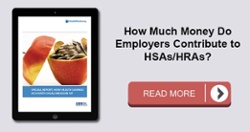
by admin | Oct 13, 2017 | ACA, ERISA, Group Benefit Plans, IRS
 On October 12, 2017, the White House released an Executive Order, signed by President Trump, titled “Promoting Healthcare Choice and Competition Across the United States.”
On October 12, 2017, the White House released an Executive Order, signed by President Trump, titled “Promoting Healthcare Choice and Competition Across the United States.”
It is important to note that the Executive Order (EO) does not implement any new laws or regulations, but instead directs various federal agencies to explore options relating to association health plans, short term limited-duration coverage (STLDI), and health reimbursement arrangements (HRAs), within the next 60 to 120 days.
The Department of Labor is ordered to explore expansion of association health plans (AHPs) by broadening the scope of ERISA to allow employers within the same line of business across the country to join together in a group health plan. The EO notes employers will not be permitted to exclude employees from an AHP or develop premiums based on health conditions. The Secretary of Labor has 60 days to consider proposing regulations or revising guidance.
Practically speaking, this type of expansion would require considerable effort with all state departments of insurance and key stakeholders across the industry. Employers should not wait to make group health plan decisions based on the EO, as it will take time for even proposed regulations to be developed.
The Department of the Treasury, Department of Labor, and Department of Health and Human Services (the agencies) are directed to consider expanding coverage options from STLDI, which are often much less expensive than Marketplace plans or employer plans. These plans are popular with individuals who are in and outside of the country or who are between jobs. The Secretaries of these agencies have 60 days to consider proposing regulations or revising guidance.
Finally, the EO directs the same three agencies to review and consider changing regulations for HRAs so employers have more flexibility when implementing them for employees. This could lead to an expanded use of HRA dollars for employees, such as for premiums. However, employers should not make any changes to existing HRAs until regulations are issued at a later date. The Secretaries have 120 days to consider proposing regulations or revising guidance.
To benchmark your current HRA plan with other employers, request UBA’s special report: How Health Savings Accounts Measure Up or download our Fast Facts on HSAs vs. HRAs.
By Danielle Capilla
Originally posted by www.UBABenefits.com

by admin | Oct 6, 2017 | ACA, IRS

Under the Patient Protection and Affordable Care Act (ACA), individuals are required to have health insurance while applicable large employers (ALEs) are required to offer health benefits to their full-time employees.
Reporting is required by employers with 50 or more full-time (or full-time equivalent) employees, insurers, or sponsors of self-funded health plans, on health coverage that is offered in order for the Internal Revenue Service (IRS) to verify that:
- Individuals have the required minimum essential coverage,
- Individuals who request premium tax credits are entitled to them, and
- ALEs are meeting their shared responsibility (play or pay) obligations.
2017 Draft Forms and Instructions
Draft instructions for both the 1094-B and 1095-B and the 1094-C and 1095-C were released, as were the draft forms for 1094-B, 1095-B, 1094-C, and 1095-C. There are no substantive changes in the forms or instructions between 2016 and 2017, beyond the further removal of now-expired forms of transition relief.
In past years the IRS provided relief to employers who make a good faith effort to comply with the information reporting requirements and determined that they will not be subject to penalties for failure to correctly or completely file. This did not apply to employers that fail to timely file or furnish a statement. For 2017, the IRS has unofficially indicated that the “good faith compliance efforts” relating to reporting requirements will not be extended. Employers should be ready to fully meet the reporting requirements in early 2018 with a high degree of accuracy. There is however relief for de minimis errors on Line 15 of the 1095-C.
The IRS also confirmed there is no code for the Form 1095-C, Line 16 to indicate an individual waived an offer of coverage. The IRS also kept the “plan start month” box as an optional item for 2017 reporting.
Employers must remember to provide all printed forms in landscape, not portrait.
When? Which Employers?
Reporting will be due early in 2018, based on coverage in 2017.
For calendar year 2017, Forms 1094-C, 1095-C, 1094-B, and 1095-B must be filed by February 28, 2018, or April 2, 2018, if filing electronically. Statements to employees must be furnished by January 31, 2018. In late 2016, a filing deadline was provided for forms due in early 2017, however it is unknown if that extension will be provided for forms due in early 2018. Until employers are told otherwise, they should plan on meeting the current deadlines.
All reporting will be for the 2017 calendar year, even for non-calendar year plans. The reporting requirements are in Sections 6055 and 6056 of the ACA.
By Danielle Capilla
Originally Published By United Benefit Advisors

by admin | Sep 29, 2017 | ACA, Compliance, IRS
 In spite of the recent efforts by Congress to change or repeal the ACA, its provisions are still in effect. The IRS has issued continuing guidance on the affordability rate for coverage, the employer shared responsibility provisions and reporting, and the individual mandate provision.
In spite of the recent efforts by Congress to change or repeal the ACA, its provisions are still in effect. The IRS has issued continuing guidance on the affordability rate for coverage, the employer shared responsibility provisions and reporting, and the individual mandate provision.
IRS Released the 2018 Affordability Rate
The Internal Revenue Service released its Revenue Procedure 2017-36, which sets the affordability percentage at 9.56 percent for 2018. Under the Patient Protection and Affordable Care Act (ACA), an applicable large employer may be liable for a penalty if a full-time employee’s share of premium for the lowest cost self-only option offered by the employer is not affordable (for 2018, if it’s more than 9.56 percent of the employee’s household income) and the employee gets a premium tax credit for Marketplace coverage.
Because the 2018 affordability rate is lower than the 2017 affordability rate, applicable large employers may need to reduce their employees’ share of premium contributions to maintain affordable coverage. Employers should double check their anticipated 2018 premiums now to prevent the need for mid-year changes.
IRS Releases Information Letters
The IRS issued Information Letters 2017-0010, 2017-0011, 2017-0013, and 2017-0017 on the ACA’s employer shared responsibility provisions and individual mandate.
IRS Information Letters 2017-0010 and 2017-0013 explain that the ACA’s employer shared responsibility provisions continue to apply. The letters state, “The [President’s January 20, 2017] Executive Order does not change the law; the legislative provisions of the ACA are still in force until changed by the Congress, and taxpayers remain required to follow the law and pay what they may owe.” Further, the letters indicate that there are no waivers from potential penalties for failing to offer health coverage to full-time employees and their dependents.
IRS Information Letters 2017-0011 and 2017-0017 address the continued application of the ACA’s individual shared responsibility provisions. Letter 2017-0017 states, “The Executive Order does not change the law; the legislative provisions of the ACA are still in force until changed by the Congress, and taxpayers remain required to follow the law, including the requirement to have minimum essential coverage for each month, qualify for a coverage exemption for the month, or make a shared responsibility payment.”
IRS Issues Draft Forms 1094/1095
The IRS issued draft Forms 1094-B, 1095-B, 1094-C, and 1095-C for the 2017 tax year. Coverage providers use Forms 1094-B and 1095-B to report health plan enrollment. Applicable large employers use Forms 1094-C and 1095-C to report information related to their employer shared responsibility provisions under the ACA.
There are no changes to the face of draft Forms 1094-B, 1095-B, or 1095-C. The IRS made one substantive change to draft Form 1094-C. The IRS removed the line 22 box “Section 4980H Transition Relief” which was applicable to the 2015 plan year only.
By Danielle Capilla
Originally Published By United Benefit Advisors
by admin | Jun 9, 2017 | HSA/HRA, IRS
IRS Releases 2018 Amounts for HSAs
The IRS released Revenue Procedure 2017-37 that sets the dollar limits for health savings accounts (HSAs) and high-deductible health plans (HDHPs) for 2018.
For calendar year 2018, the annual contribution limit for an individual with self-only coverage under an HDHP is $3,450, and the annual contribution limit for an individual with family coverage under an HDHP is $6,900. How much should an employer contribute to an HSA? Read our latest news release for information on modest contribution strategies that are still driving enrollment in HSA and HRA plans.
For calendar year 2018, a “high deductible health plan” is defined as a health plan with an annual deductible that is not less than $1,350 for self-only coverage or $2,700 for family coverage, and the annual out-of-pocket expenses (deductibles, co-payments, and other amounts, but not premiums) do not exceed $6,650 for self-only coverage or $13,300 for family coverage.
Retroactive Medicare Coverage Effect on HSA Contributions
The Internal Revenue Service (IRS) recently released a letter regarding retroactive Medicare coverage and health savings account (HSA) contributions.
As background, Medicare Part A coverage begins the month an individual turns age 65, provided the individual files an application for Medicare Part A (or for Social Security or Railroad Retirement Board benefits) within six months of the month in which the individual turns age 65. If the individual files an application more than six months after turning age 65, Medicare Part A coverage will be retroactive for six months.
Individuals who delayed applying for Medicare and were later covered by Medicare retroactively to the month they turned 65 (or six months, if later) cannot make contributions to the HSA for the period of retroactive coverage. There are no exceptions to this rule.
However, if they contributed to an HSA during the months that were retroactively covered by Medicare and, as a result, had contributions in excess of the annual limitation, they may withdraw the excess contributions (and any net income attributable to the excess contribution) from the HSA.
They can make the withdrawal without penalty if they do so by the due date for the return (with extensions). Further, an individual generally may withdraw amounts from an HSA after reaching Medicare eligibility age without penalty. (However, the individual must include both types of withdrawals in income for federal tax purposes to the extent the amounts were previously excluded from taxable income.)
If an excess contribution is not withdrawn by the due date of the federal tax return for the taxable year, it is subject to an excise tax under the Internal Revenue Code. This tax is intended to recapture the benefits of any tax-free earning on the excess contribution.
By Danielle Capilla
Originally Posted By www.ubabenefits.com

by admin | Jun 6, 2017 | Employee Benefits, IRS
 Under Internal Revenue Code Section 105(h), a self-funded medical reimbursement plan must pass two nondiscrimination tests. Failure to pass either test means that the favorable tax treatment for highly compensated individuals who participate in the plan will be lost. The Section 105(h) rules only affect whether reimbursement (including payments to health care providers) under a self-funded plan is taxable.
Under Internal Revenue Code Section 105(h), a self-funded medical reimbursement plan must pass two nondiscrimination tests. Failure to pass either test means that the favorable tax treatment for highly compensated individuals who participate in the plan will be lost. The Section 105(h) rules only affect whether reimbursement (including payments to health care providers) under a self-funded plan is taxable.
When Section 105(h) was enacted, its nondiscrimination testing applied solely to self-funded plans. Under the Patient Protection and Affordable Care Act (ACA), Section 105(h) also applies to fully insured, non-grandfathered plans. However, in late 2010, the government delayed enforcement of Section 105(h) against fully insured, non-grandfathered plans until the first plan year beginning after regulations are issued. To date, no regulations have been issued so there is currently no penalty for noncompliance.
Practically speaking, if a plan treats all employees the same, then it is unlikely that the plan will fail Section 105(h) nondiscrimination testing.
What Is a Self-Insured Medical Reimbursement Plan?
Section 105(h) applies to a “self-funded medical reimbursement plan,” which is an employer plan to reimburse employees for medical care expenses listed under Code Section 213(d) for which reimbursement is not provided under a policy of accident or health insurance.
Common self-funded medical reimbursement plans are self-funded major medical plans, health reimbursement arrangements (HRAs), and medical expense reimbursement plans (MERPs). Many employers who sponsor an insured plan may also have a self-funded plan; that self-funded plan is subject to the Section 105 non-discrimination rules. For example, many employers offer a fully insured major medical plan that is integrated with an HRA to reimburse expenses incurred before a participant meets the plan deductible.
What If the Self-Insured Medical Reimbursement Plan Is Offered Under a Cafeteria Plan?
A self-funded medical reimbursement plan (self-funded plan) can be offered outside of a cafeteria plan or under a cafeteria plan. Section 105(h) nondiscrimination testing applies in both cases.
Regardless of grandfathered status, if the self-funded plan is offered under a cafeteria plan and allows employees to pay premiums on a pre-tax basis, then the plan is still subject to the Section 125 nondiscrimination rules. The cafeteria plan rules affect whether contributions are taxable; if contributions are taxable, then the Section 105(h) rules do not apply.
What Is the Purpose of Nondiscrimination Testing?
Congress permits self-funded medical reimbursement plans to provide tax-free benefits. However, Congress wanted employers to provide these tax-free benefits to their regular employees, not just to their executives. Nondiscrimination testing is designed to encourage employers to provide benefits to their employees in a way that does not discriminate in favor of employees who are highly paid or high ranking.
If a plan fails the nondiscrimination testing, the regular employees will not lose the tax benefits of the self-funded medical reimbursement plan and the plan will not be invalidated. However, highly paid or high ranking employees may be adversely affected if the plan fails testing.
What Are the Two Nondiscrimination Tests?
The two nondiscrimination tests are the Eligibility Test and Benefits Test.
The Eligibility Test answers the basic question of whether there are enough regular employees benefitting from the plan. Section 105(h) provides three ways of passing the Eligibility Test:
- The 70% Test – 70 percent or more of all employees benefit under the plan.
- The 70% / 80% Test – At least 70 percent of employees are eligible under the plan and at least 80 percent or more of those eligible employees participate in the plan.
- The Nondiscriminatory Classification Test – Employees qualify for the plan under a classification set up by the employer that is found by the IRS not to be discriminatory in favor of highly compensated individuals.
The Benefits Test answers the basic question of whether all participants are eligible for the same benefits.
By Danielle Capilla
Originally Posted By www.ubabenefits.com

by admin | Jun 1, 2017 | Benefit Management, ERISA, HSA/HRA, IRS
 Certain small employers have the option to reimburse individual health coverage premiums up to a dollar limit through Qualified Small Employer Health Reimbursement Arrangements (QSE HRAs) under the 21st Century Cures Act (Cures Act).
Certain small employers have the option to reimburse individual health coverage premiums up to a dollar limit through Qualified Small Employer Health Reimbursement Arrangements (QSE HRAs) under the 21st Century Cures Act (Cures Act).
The Cures Act amends the Employee Retirement Income Security Act of 1974 (ERISA) to exclude QSE HRAs from the ERISA definition of group health plan; however, the Cures Act does not specifically exclude QSE HRAs from the rest of ERISA.
Small employers that plan to offer QSE HRAs should be cautious before presuming that ERISA would not apply to a reimbursement arrangement. Because QSE HRAs are new, the issue of whether the remainder of ERISA applies to QSE HRAs remains undetermined by an administrative agency or court. In consideration of the limited ERISA group health definition exclusion and the law’s legislative history, a risk-averse small employer should treat a QSE HRA as an employee welfare benefit plan covered under ERISA and comply with applicable ERISA requirements such as having a written plan document and summary plan description as well as following ERISA’s fiduciary and other rules.
Request UBA’s Compliance Advisor, “Qualified Small Employer Health Reimbursement Arrangements and ERISA” for a discussion of ERISA’s definitions of “group health plan,” as well as the law’s legislative history governing exclusions. A small employer who intends to offer a QSE HRA without complying with ERISA’s employee welfare benefit plan requirements should consult with its attorney before proceeding.
By Danielle Capilla
Originally Posted By www.ubabenefits.com

 On October 12, 2017, the White House released an Executive Order, signed by President Trump, titled “Promoting Healthcare Choice and Competition Across the United States.”
On October 12, 2017, the White House released an Executive Order, signed by President Trump, titled “Promoting Healthcare Choice and Competition Across the United States.”



